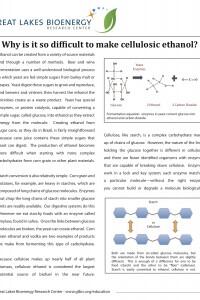Why Is It So Difficult to Create Cellulosic Ethanol
Ethanol can be created from a variety of source materials and through a number of methods. Beer and wine fermentation uses a well-understood biological process in which yeast are fed simple sugars from barley malt or grapes. Yeast digest these sugars to grow and reproduce, and brewers and vintners then harvest the ethanol the microbes create as a waste product. Yeast has special enzymes, or protein catalysts, capable of converting a simple sugar, called glucose, into ethanol as they extract energy from the molecule. Creating ethanol from sugar cane, as they do in Brazil, is fairly straightforward because cane juice contains these simple sugars that yeast can digest. The production of ethanol becomes more difficult when starting with more complex carbohydrates from corn grain or other plant materials.
Starch conversion is also relatively simple. Corn grain and potatoes, for example, are heavy in starches, which are composed of long chains of glucose molecules. Enzymes that chop the long chains of starch into smaller glucose units are readily available. Our digestive systems do this whenever we eat starchy foods with an enzyme called amylase, found in saliva. Once the links between glucose molecules are broken, the yeast can create ethanol. Corn grain ethanol and vodka are two examples of products we make from fermenting this type of carbohydrate.
| Attachment | Size |
|---|---|
| Why is it so difficult to make cellulosic ethanol-.pdf | 1.44 MB |
